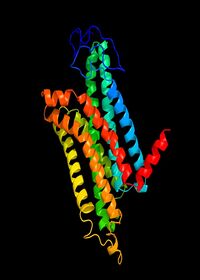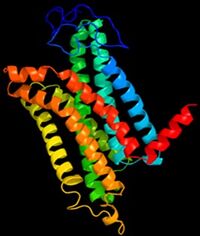User:Henna Devi/melanocortin 1 receptor
From Proteopedia
| Line 1: | Line 1: | ||
| - | <Structure load='6w25' size='350' frame='true' align='right' caption=' | + | <Structure load='6w25' size='350' frame='true' align='right' caption='Modified Melanocortin 4 Receptor' scene='86/868791/Alices_rainbow_selection/1' /> |
==Melanocortin 1 Receptor: An insight to MCR1 structure, function and regulation== | ==Melanocortin 1 Receptor: An insight to MCR1 structure, function and regulation== | ||
===Introduction to MC1R=== | ===Introduction to MC1R=== | ||
Revision as of 07:42, 12 April 2021
|
Contents |
Melanocortin 1 Receptor: An insight to MCR1 structure, function and regulation
Introduction to MC1R
The highly polymorphic human MC1R gene, located on chromosome 16q24.3 encodes for a MCR1 receptor also known as melanocyte -stimulating hormone receptor. The melanocortin receptor family consists of five members: MC1R, MCR2, MCR3, MC4R and MC5R all of which exhibit functions and are expressed differently (Wolf Horrell, Boulanger and D’Orazio, 2016). The gene is expressed in melanocytes along with other cell types that inhabit the skin such as keratinocytes and fibroblast as well as cells that operate the immune system (Gruis and Doorn, 2012). The activation of the MC1R receptor by ultraviolet radiation increases the production of the dark eumelanin pigment, resulting in the darkening of the skin. MCR1 stimulation also results in increased melanocyte dendricity, proliferation, cell survival and DNA repair. The loss of melanocortin receptor function results in the production of the red/yellow pheomelanin pigment by melanocytes, resulting in the red hair, fair skin, poor tanning, freckling and increased skin cancer risk in humans (Beaumont et al., 2011).
MC1R Structure
The mature MC1R protein is made up of 317 amino acids and a 7 a-helical transmembrane domain. Based on the sequence similarity analysis, the melanocortin receptor family belong to the class A of G-coupled protein receptors therefore direct information on their secondary and tertiary structures is limited as G coupled protein receptors are resistant to crystallisation (Garcia-Borron, Sanchez-Laorden and Jimenez-Cervantes, 2005) (Zhao and Wu, 2012). Wolf Horrell, Boulanger and D’Orazio describe the melanocortin 1 receptor in four catergoies: The N and C terminus and the Intracellular and Extracellular loops. The N-terminus is the amino-terminal extracellular head which plays an important role in ligand affinity. The C terminus is the carboxyl-terminal cytoplasmic tail which is 14 amino acids long and is necessary for the trafficking of proteins affecting receptor localisation to the plasma membrane (Sharma and Schiller, 2019). As a short residue, the c-terminal uses molecular recognition for its function through its polarity. There are 3 intracellular loops and 3 extracellular loops (Figure 1) found between the transmembrane regions of MCR1. The Intracellular loops play an important role in G-coupled proteins for binding and signalling. MCR1 extracellular loops are essential for signalling activity. Extracellular loop 3 is crucial for cell surface receptor expression (Barwell, Conner and Poyner, 2011).
Determination of MC1R 3D Structure
As a GPCR there is a paucity of structural data (Dastmalchi, Church and Morris, 2008) as general difficulties that have been long known in crystalising membrane proteins, the flexibility of the receptor causes obstruction. The known difficulty in crystalising G-coupled proteins may be the significant reason for the incomplete 3D structural data for the melanocortin 1 receptor protein. However two structures with great similarlity have been detetced for the MC1R , Figure 1. and Figure 2. are estimated 3D structures. The 7 helices are shown in different colours.
Associated diseases
Melanoma
Melanoma is a type of skin cancer which is commonly recognised through the detection of a new mole or noticeable changes in a mole which was already developed (NHS Choices, 2019). Melanoma is related to UV exposure often from the intense exposure of people with more pale skin to UV
Vitilgo
Vitiligo is an autoimmune disease where the immune system attacks melanocytes in the skin resulting in a loss of pigmentation (medlineplus.gov, n.d.). The condition exists in two forms nonsegmental and segmental vitiligo. Recent studies (Ocampo‑Garza et al., 2020) concluded that genes involved in the melanocortin system related to the re-pigmentation progress in stable vitiligo patients, mainly MCR1 with a probability <0.05 showing results were significant.
Drug binding: Afamelanotide
Afamelanotide is a potent drug which binds to the melanocortin-1 receptor and stimulates melanocyte proliferation and melanogenesis therefore a MC1R agonist.
MC4R Ligands
,
, , ,


